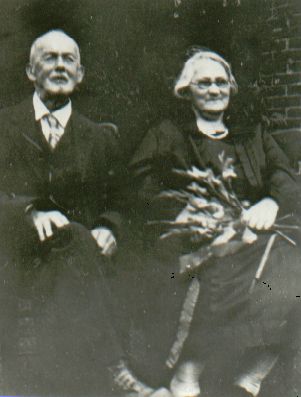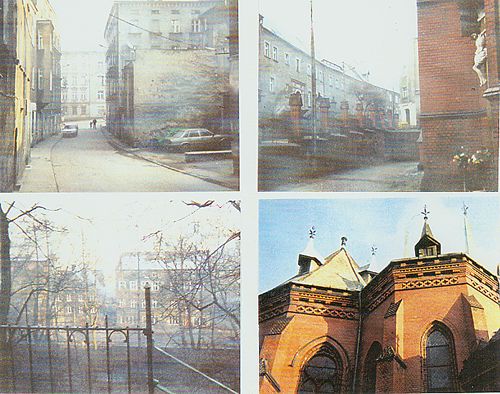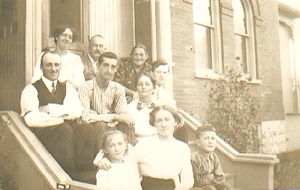
Theobald & Mary Hannusch (50th Anniversary)
THEOBALD HANNUSCH (Johannes, Ignac, Josef)
Theobald Hannusch was born in the small village of Buchau, Silesia, (now Poland), on September 28, 1852, at 10:00 PM. He was christened in the Roman Catholic Church, by Father P. Schofster (sponsors August Moschner of Schlegel and Nelene Frederick of Buchau; and Josepha & Wilhelm Meese of Kohlendorf), at Neurode, Silesia (now Nowa Ruda, Poland), on September 30, 1852.
He concluded his formal education at home and in the local schools of Buchau. It was here that he was apprenticed under his father's direction, into the family tailor craft.
As suggested from his statement to the "Hamburg Germany Passenger Authority," in 1879, it would appear that, in about 1857, the Hannusch Family removed from Buchau to the small village of Louisenhein, Silesia.

Neurode Roman Catholic Church Yard
Miilitary service was a natural part of growing up. Theobald Hannusch became a part of this military tradition (a portrait of him, in uniform, in the possession of his son Elimar). He often repeated the story that he "had made his own uniform." A family tradition states that he left the Prussian military before his tour of duty was completed to join his father and brother in Canada. Wild tales of flight have been related, but I have no solid evidence to this fact. "Whatever the story, be it true, be it false, apparently it had all been cleared up," his son Elimar relates, "he was making plans to visit his family in Poland, after his retirement, and nothing in Germany seemed to stand in his way."
On July 9, 1879, Theobald Hannusch, in Hamburg, Germany, boarded the steamship "Frista," under the command of Captain Meyer, and following a brief stop in LeHarve, France, arrived at the port of New York, on July 22, 1879. At Heidelberg, Ontario, Canada he joined his father and brother in their tailor business.
August 31, 1880, Theobald Hannusch stood before the alter, in the Roman Catholic Church of St. Clement's, and exchanged the vows of marriage with Mary Gies, the daughter of Frederick and Susanna (Straus) Gies, of Bamberg, Ontario. Carl Gies and Amelia Walter witnessed the vows. Children: 1) Alfred Hannusch, b. July 28, 1881; 2) Arthur Hannusch, b. November 3, 1883; 3) Alma Hannusch, b. June 11, 1885; 4) Melitta Hannusch, b. June 2, 1887; 5) Armond (Herbert) Hannusch, b. July 25, 1889; 6) Wanda Hannusch, b. August 6, 1891; 7) Alfonso Hannusch, b. December 18, 1894; 8) Elimar Hugo Hannusch, b. January 10, 1902; 9) Ada Hannusch, b. July 21, 1904.

St. Clements Roman Catholic Church
Theobald Hannusch continued in the tailor craft in the village of Heidelberg, Ontario until his father's death, in the spring of 1885. It was soon after that event that he moved, with his young family, into the City of Berlin, Ontario.
"He first opened a tailor shop on Queen Street, beside the arena, and lived in one of two houses behind it," his son, Elimar, relates.
It is not clear, at this time, when the family home and farm at 66 Bloucher Street was acquired, but according to birth records and related stories it was apparently purchased in about 1886. Here, with no record of business establishment, he apparently worked out of his home.

Family Gathering
In a letter to his brother, Hugo Hannusch, then living in Philadelphia, Theobald Hannusch spoke of wanting to take a trip to Chicago after travel to Philadelphia to visit with his brother. In the letter they concluded that the financial conditions of the country and at home would not allow for either trip. In 1898 he received the news and description of his mother's death and burial in Neurode, Silesia.
"My mother used to tell stories," Mrs. Pearl Rafferty related, "how Grandad used to travel on horseback, to the City of Hamilton, to get supplies that weren't available in Berlin. He would be gone for days as there weren't any roads then."
In about 1900 his brother, Hugo Hannusch, left Philadelphia to return home to Neurode, Silesia. The stories circulated in the family, in Canada, say that he went down with the ship enroute home. The middle name given to Elimar Hugo Hannusch, in 1902, would tend to bear out these stories. Yet, in the Neurode Church records index, "Hugo Hannusch' two day old daughter was christened in 1901." This will have to remain a mystery until later records are available to clarify it.
January 4, 1901, in the name of Mary Hannusch, the building located at 108 Ahrens Street, Berlin, Ontario was purchased from the estate of John H. Branduski. This served Theobald Hannusch, and his family, as a combined tailor shop and grocery store, for near two decades. In the city directory of l908-09, Theobald Hannusch is listed as, "grocer."
The City of Berlin, from it's beginning, had developed into one of Ontario's leading industrial centers. The underlying friction between the German and English speaking population festered over the years, but the German majority usually won out. "World War I" brought a new reason to the surface and it developed into a bitter struggle. This time the English speaking population won out and, in 1917, the city of Berlin was renamed after the English hero, "Lord Horatio Kitchener."
"One evening, after he closed the store," Elimar Hannusch related, "my father was walking home alone when two young men held him up at gunpoint and took the day's receipts. He was shaking when he finally arrived at home. After that," Elimar Hannusch added, "I accompanied him on his way home."
That same year Theobald Hannusch purchased a small farm, on the Blair Road: located near the farms of son, Alfred and daughter, Mrs. Alma Rafferty. In 1918 the Bloucher Street home was apparently rented out and he moved his family to the farm. His son, Elimar, took charge of the farm duties while he continued his tailor business.
In 1926 the house at 66 Bloucher Street was sold to Mr. Stailey. Though that, red brick, two story home still stands today, under more crowded circumstances, the extent of its surrounding land can be imagined. It is no longer addressed on Bloucher Street; a much newer home now sits on the lot in front of it and takes this address.
The business, at 108 Ahrens, appears to have been sold in that same year.
On August 3, 1926, in the name of Mary Hannusch, a house at 52 York Street, in Kitchener, Ontario was purchased. At this time the farm was left in the hands of their son, Elimar, and the family returned to the City Kitchener.
The 1930's listed Theobald Hannusch as retired. With that retirement, the unbroken line of tailors, in our family line, came to an end.
August 30, 1930, at their York Street home, Theobald and Mary (Gies) Hannusch were honored by a family gathering, held on the occasion of their "Golden Wedding" Anniversary.
Throughout his life in Canada, close friends, business associates, customers, and family all spoke German. This negated the necessity to learn or use the English language. Thus, to his death, Theobald Hannusch never really spoke English. When the necessity to use the English language arose in his daily life, his wife was his interpreter.
His enjoyment of the violin led some of his sons to follow the same path in home and family entertainment.
In 1932, through letters from his nephew, Karl Thurmer, Theobald Hannusch received the news and details of his sister's (Adelheide) last days and death in Neurode, Silesia.
A tumble on the ice left Theobald Hannusch with a broken hip. A second fall reinjured the break and complications set in. On Friday, November 2, 1934, at St. Mary's Hospital, Kitchener, Ontario, Theobald Hannusch succumbed to his injuries.
He was interred in the Roman Catholic Mausoleum, at Woodland Cemetery, Kitchener, Ontario, Canada.
His wife, Mary (Gies) Hannusch, succumbed to cancer on July 23, 1938.
ADELHEIDE HANNUSCH (Johannes, Ignac, Josef)
Adelheide Hannusch was born March 7,1851, at Buchau, Silesia and raised to maturity first in that community and then in Louisenhein, Silesia.
A letter received by Theobald Hannusch, in 1932, signed by Karl Thurmer, (states Adelheide's husband was uncle to my father) would suggest Adelheide Hannusch had married into the Thurmer family. (Another letter states that she was an aunt to Max Weber.)
A letter dated June 13, 1932, states, "that Theobald's sister was sick, she had nothing to bequest, everything lost through inflation including the house she lived in, she gave verbal will that her furniture to be divided among the family."
June 16, 1932, Adelheide (Hannusch) Thurmer died at Neurode, Silesia, Poland. The letter states "she is buried on a beautiful hill."
HUGO HANNUSCH (Johannes, Ignac, Josef)
Hugo Hannusch was born, on October 12, 1854, at Buchau, Silesia, and christened two days later in the Roman Catholic Church at Neurode, Silesia.
He was raised to maturity in Buchau and, in all probability, concluded his formal education in Louisenhein, Silesia. At about the age of thirteen, under his father's direction, he apprenticed in the traditional family tailor trade.
Hugo Hannusch stated he was married prior to his departure for Canada. According to the Church Index, his wife would have been *Ema Kuhnert. Children: *Margaretha Hannusch, b. November 9, 1900.
He came to Heidelberg, Ontario, Canada in the mid to late 1870's with his father. Here father and son established their tailor business. Apparently he remained in the family business, in Heidelberg, Ontario, after his father's death and his brother, Theobald, had removed to Berlin, Ontario.
Sometime, early in the last decade of the century, Hugo Hannusch left Canada and established himself in the United States. A letter to his brother, Theobald, in 1897, records that "he had worked in Philadelphia, Pennsylvania for a period of three years." Philadelphia's "City Directory" confirms that, "Hugo Hannusch, a tailor by trade, resided at 326 Crown Street, Philadelphia." His name was absent from later directories as well as from the 1900 United States census.
A letter he sent to his brother, Theobald, dated 1897, from Philadelphia, stated that, "he was very busy at work," "he was satisfied with his work," "he was still at his first job in the city," "that he had purchased four tickets for the voyage and sent them home for the four girls, daughters of his wife's sister, to come to America where it would be easier for them (no more is known of this plan),""he spoke of his brother's wanting to see him as well as they visit Chicago, but could not afford the trip, and he said, "I'm in the same fix."
He makes mention to his brother, Theobald, of a wife in Silesia, but no mention of his marriage has been found in the Neurode Catholic Church records. Canadian family members are given to understand that he sailed for home some time around the turn of the century. Not heard from there after, by the younger members of the family, it is believed (by his nephew from overheard conversations), that the ship had gone down and Hugo Hannusch had been lost at sea. The use of Hugo's name, in 1902, far from the routine of the Theobald Hannusch family name selecting policy, would suggest that something dramatic probably took place.
*Though the actual records have not been made available, the Neurode, Silesia Roman Catholic Church records index for 1900 states: "a Hugo Hanisch (as their mother's surname had been spelled in these records) and Ema Kuhnert were the parents of Margaretha Hanisch, born November 9, 1900, and christened November 18, 1900, at Neurode." Another Hugo is possible, but it does not seem logical as there are no other Hannusch, or associated family names found in these records.
WALDBERGER HANNUSCH (Johannes, Ignac, Josef)
Waldberger or Waldberga Hannusch was born in December 1856, at Buchau, Silesia and christened on January 1, 1857, in Neurode, Silesia. Nothing more is known except for the suggestion of a daughter who died in her youth.
© 1985-2002

